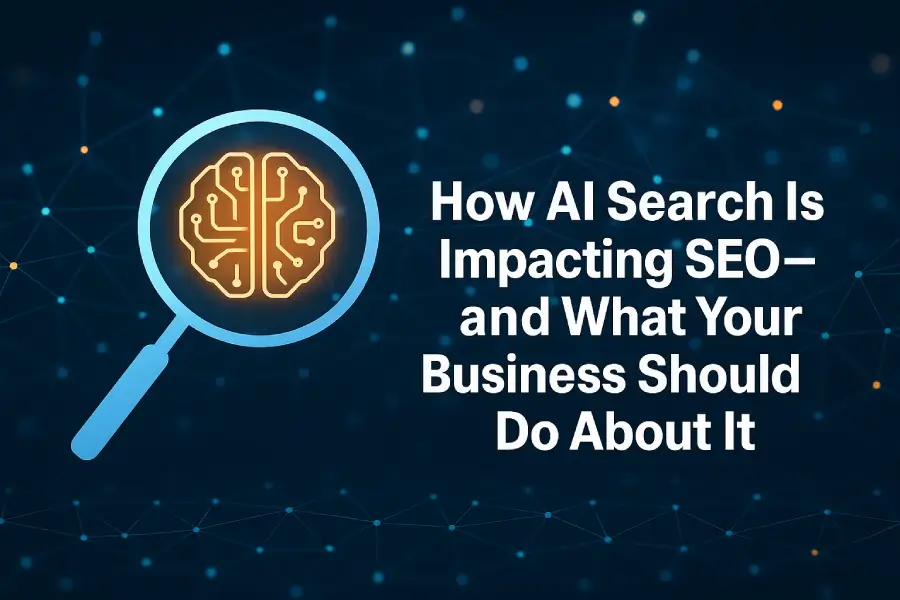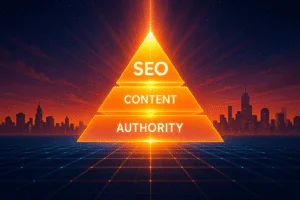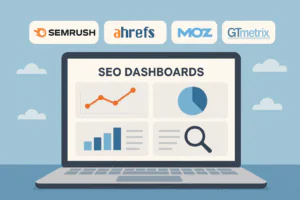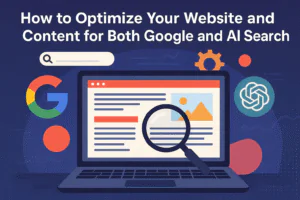AI isn’t “coming”—it’s already changing how people discover answers and vendors. Google’s AI Overviews (and now AI Mode), Microsoft’s Copilot Search, Perplexity, and ChatGPT Search all summarize the web and surface cited sources directly in the results. If you’re not building content designed to be selected by AI—not just ranked by algorithms—you’ll lose visibility even if you’ve historically ranked well.
This article breaks down what’s changed, what matters now, and exactly how to adapt.
What is AI Search—and how is it different?
Traditional search ranked a list of links based on signals like relevance, links, and behavior. AI search synthesizes an answer first, then attaches citations so users can verify and go deeper.
- Google AI Overviews & AI Mode: AI-generated summaries and a dedicated AI Mode tab; Google says the experience includes prominent links and continues sending “high‑quality clicks.” Rollout began in May 2024 and continues to expand.
- Bing Copilot Search: Merges generative answers with traditional web results and clearly cited sources, and you can expand.
- Perplexity: Positions itself as an “answer engine,” performing real‑time searches with linked citations; offers Deep Research for longer reports.
- ChatGPT Search & Connectors: ChatGPT now offers ChatGPT Search in-app and on the web; connectors (Drive, SharePoint, GitHub, etc.) pull live content into answers.
Bottom line: answers first, links second. Your content must be answer‑worthy—clear, verifiable, and structured—so these systems choose and cite you.
Why this changes SEO
- More zero‑click behavior on quick facts. For simple lookups, users may stop at the overview. Google acknowledges this but also reports that overall organic click volume remains relatively stable and click quality is up—users who do click are more engaged. Your results will depend on query types.
- Fragmented starting points. Search journeys now start across Google, Copilot, Perplexity, and ChatGPT—not only Google. Your discoverability must span multiple answer engines.
- Intent and context matter more than keywords. AI systems map concepts and entities, not just phrases. Content that directly resolves the user’s question, with precise definitions, examples, and decision criteria, wins.
- Authority & trust signals are essential. Google’s E‑E‑A‑T framework guides quality evaluations. It’s not a direct ranking factor, but aligning to it (real expertise, experience, authorship, and trust) correlates with better visibility.
How to adapt your strategy for AI‑driven search
1) Make “question‑first” content your standard
Write to the exact questions buyers ask—in their words. (This is why They Ask, You Answer works.) Use H2/H3 questions, then give a direct, scannable answer in 2–4 sentences before deeper context.
Example
Instead of “Best Office Printers 2025,” target: “What’s the most reliable office printer under $2,000?” Include use cases, total cost to own, supplies yield, duty cycle, and who should not buy it.
2) Provide context‑rich, fact‑checked answers
Define terms (“pull printing,” “firmware allow‑listing”), provide step‑by‑steps, caveats, and cite sources where helpful. For Google, “verifiability” plus helpful links is explicitly emphasized in AI experiences.
3) Add structured data the right way
Markup helps search engines understand your page and eligibility for rich experiences, even when certain rich results (like FAQs/How‑Tos) are limited. Prioritize: Organization, WebPage/Article, Product/Offer (with Merchant Center when relevant), HowTo (when genuinely instructional), FAQPage (use sparingly; see caveat).
Note: Google now restricts FAQ rich results to well‑known gov/health sites. Keep the content if it helps users and AI models, but don’t expect the old FAQ rich snippet visually.
4) Build topical authority with clusters
Create a pillar page for the big question and interlink in‑depth articles answering each sub‑question (cost, comparisons, security, setup, troubleshooting). Include first‑party evidence: screenshots, test data, photos, and customer quotes.
5) Optimize for each answer engine
- Google: Write for AI Overviews + traditional results. Include crisp definitions, clear pros/cons, and links to primary sources. Be aware of the Web filter, which lets users see link‑only results; your classic SEO must still hold up.
- Bing Copilot Search: Expect prominent citations with a “see all sources” expansion. Make your titles and meta clear; use comparison tables and checklists that Copilot can lift.
- Perplexity: It always shows sources. Write concise, well‑cited explainers and “what to consider” lists. Perplexity’s Deep Research mode builds reports—your comprehensive guides and original data are prime candidates to be cited.
- ChatGPT Search: Treat it like a blended search + reading experience. Clear headings, straightforward takeaways, and strong source pages increase the odds that your content is surfaced and cited. Connectors also mean users may query their files alongside the web; your public content must stand on its own.
What does this mean for
Local SEO
For print technology providers, MPS, and IT services, three factors still drive local packs: relevance, distance, and prominence. Nail the basics: accurate NAP, primary/secondary categories, hours, services, and review generation. Encourage detailed reviews that mention service types and locations.
Do this now
- Fully complete and verify your Google Business Profile; keep hours and services current. Add photos/videos.
- Publish local content (“managed print services in Harrisburg: pricing, response times, SLAs”) that answers geo‑specific questions AI engines can quote.
- Use UTM links in GBP to measure profile‑driven traffic and conversions.
Measurement: what to track (beyond rank)
- Search Console: Query‑level impressions/CTR for your question‑led pages; changes after content refreshes.
- Bing Webmaster Tools: Impressions/clicks for cluster pages.
- AI answer coverage (manual): Monthly scorecard (see checklist).
- Engagement quality: Time on page, scroll depth, conversion on “what next” CTAs (e.g., calculator, comparison PDF).
- E‑E‑A‑T signals: Author pages, credentials, dates of last update, outbound citations to primary sources. (E‑E‑A‑T is guidance, not a ranking factor.)
Competitive Visibility Checklist (Google, Bing Copilot, Perplexity, ChatGPT)
How to use this: pick your top 25 buyer‑intent queries (mix of “what is,” “cost,” “best,” “compare,” brand + category, and local). Run the steps below monthly and score 0–2 for each item (0 = absent, 1 = partial, 2 = strong). Total /100 for a simple “share of answer” index.
Google (AI Overviews / AI Mode)
- Do we appear as a cited link in the AI Overview for the query? (Y/N; capture screenshot and cited sentence.)
- If not cited, what do cited pages include that ours lacks? (Definitions, pros/cons, pricing, visuals, step‑by‑steps, original data?)
- Does our page load fast, answer directly in the first 2–4 sentences, and include a plain‑English summary box?
- Is the classic “10 blue links” position still competitive when users toggle the Web filter?
Bing Copilot Search
- Are we in the source list behind Copilot’s answer? If not, what patterns do cited pages share (tables, comparisons, recency)?
- Does our title/meta make the page’s purpose unambiguous?
- Do we supply concise checklists that Copilot can quote?
Perplexity
- Are we cited for the query in Quick Search and in Deep Research?
- Do we have a compact “explainer + decision criteria + sources” format for this topic?
- Is there an original graphic/table we control that Perplexity can reference?
ChatGPT Search
- Does ChatGPT surface our page with a clickable citation?
- Would a skimming user get the answer from our H2/H3 structure alone?
- Is our content dated/maintained (update note + author bio) to build trust?
Local layer (all queries with place intent)
- Are we consistently present in the local pack/map for the city‑specific version of the query?
- Do reviews mention the service by name and city (natural language, not spam)?
Your 30/60/90‑day plan
Next 30 days
- Select the 25 priority questions and map them to pages (create if missing).
- Add direct answers at the top of each page, plus a TL;DR summary.
- Implement/validate core schema (Organization, Article/WebPage, Product/Offer, where relevant).
- Tighten GBP: categories, services, hours; request 10 new reviews with specific service mentions.
60 days
- Build one pillar + 6–10 supporting articles for a high‑value topic (e.g., “Managed Print Services Pricing & ROI”).
- Add comparison tables, pros/cons, and decision criteria to each article.
- Publish one original data point (internal benchmarks, anonymized TTR, uptime, or supplies yield testing).
90 days
- Run the visibility checklist; capture screenshots; prioritize gaps where you were absent or cited below competitors.
- Expand the cluster with how‑to and security subtopics (e.g., pull printing, firmware allow‑listing, PaperCut/uniFLOW setup).
- Repurpose into short videos and slides to feed YouTube/LinkedIn—two surfaces AI engines often cite.
Final thoughts
AI search rewards clarity, credibility, and real expertise. Build pages that answer the question decisively, support it with specifics, and make verification easy. Keep your local profile clean and current. Measure monthly. Improve what the AI engines keep choosing.
Doceo can help you win in AI search
At Doceo, our Marketing Services Team will help you build question‑first, high‑authority content that shows up in AI answers across Google, Copilot Search, Perplexity, and ChatGPT Search—so you stay visible and convert the right buyers.
📞 888‑757‑6626





